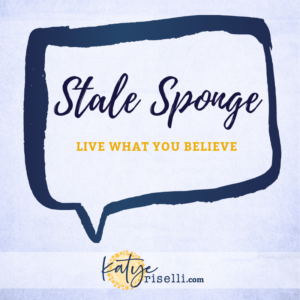 Earlier this year I had this image of a sponge full of water, left in the kitchen sink, over night. It’s a familiar image, as I’ve discovered just such a sponge in my sink more than once. That sponge is cold. It’s soggy, and when you pick it up, it drips cold, sometimes greasy water. And it smells awful. It’s a stale sponge.
Earlier this year I had this image of a sponge full of water, left in the kitchen sink, over night. It’s a familiar image, as I’ve discovered just such a sponge in my sink more than once. That sponge is cold. It’s soggy, and when you pick it up, it drips cold, sometimes greasy water. And it smells awful. It’s a stale sponge.
The stale sponge might be one of my biggest pet peeves. Quite frankly, I don’t have many, and I’m grateful for a husband who rarely does those pesky things that quickly become a pet peeve. More often than not, he’s a gem. All that said, the stale sponge is a frequent find in my kitchen sink. Since it’s usually there because he’s done the dishes, emptied the dishwasher, or some other kitchen chores for me, I rarely complain about the stale sponge. I squeeze it out, rinse it thoroughly, use it to clean whatever brought me to the kitchen sink, rinse it again, squeeze it out, and then put it up to dry on the rack so it’s ready to be used again.
Recently though, the stale sponge spoke to me. (Not literally, that would be weird.) But the picture of the stale sponge was crystal clear to me, and suddenly, I knew that I’d become a stale sponge. It’s been a jarring realization, and analogy that, if taken too far, ceases to be instructive. But stick with me for just a moment.
A stale sponge is soggy and wet because it had been useful. It’s full of water, left over water from the last time it was doing it’s job – to clean something, to wipe away the grime and grit, and return the kitchen counter or the dishes to their original state, ready to be used again. Chances are, the last time that sponge was used it was warm, soapy water in the sponge, and the combination of warm soapy water and a good sponge, along with a good scrub, equals a clean kitchen.
But the stale sponge is cold and the water is sour, and the combination is not helpful in the least. (Except maybe to do some home science experiments about growing mold.)
This is what the stale sponge said to me, “Katye, you’re stale. You’ve been useful, but you’ve got a lot of old water taking up space in you. There’s no room for fresh water, and you’re not useful like this.”
Truth.
What’s more, I recognized that what comes out of stale sponge is sour water, and that water isn’t the water I want to use to clean my kitchen. When I’m stale, what comes out of me is sour: my words, my attitude, my worldview…When all these are sour they are not only not useful but they are destructive – to me and those around me. Left unchecked, that stale sponge grows mold, and since I’m highly allergic to mold that means it becomes toxic.
I don’t enjoy being stale.
I’m certainly not interested in becoming toxic.
Revelation 2 offers a gentle rebuke and simple instruction to believers who are stale:
“I know your hard work and patient endurance…But I hold this against you – you have forsaken your first love…Do the things you once did.”
Reading those words gave me pause. The stale sponge is a picture of what my life becomes when I’m believing what I live.
Believing what I live subtly breeds discontent in my life. When I’m believing what I live, I’m susceptible to the quiet lie that there’s more to do, more to have, or more to be. What is good can quickly become not good enough, and the pursuit of perfection creates restlessness and feeds my bullying inner critic. Believing what I live places the burden of proof on the life around me, rather than the truths that inform my faith. Believing what I live leaves me weary, discouraged, and looking for real hope.
When I’m believing what I live, I’m the stale sponge. My life is defined by my emotions and my circumstances rather than what I believe.
Choosing to live what I believe redefines the landscape of my life.
More and more, when I find myself sour, I’m pausing to ask myself, “What do I believe? Am I living it? Or am I believing what I live?” Defining what I believe, reminding myself what I believe, squeezes out the stale water and replaces it with living water. Renewing my mind with what is true fills me with what is good, lovely, admirable, and noble. When I’m full of what is praiseworthy, there’s little room left for that inner critic. Living what I believe quiets the bully and empowers me to become who God designed me to be, to be used for His purposes in my home and in my community. (Just like rinsing out the stale sponge makes it ready to use.)
What Do I Believe? * John 7:37-38 * Romans 12:2 * Philippians 4:8 *
Photo Credit: Emmie Walch, It’s ME, Eloise! Photography




